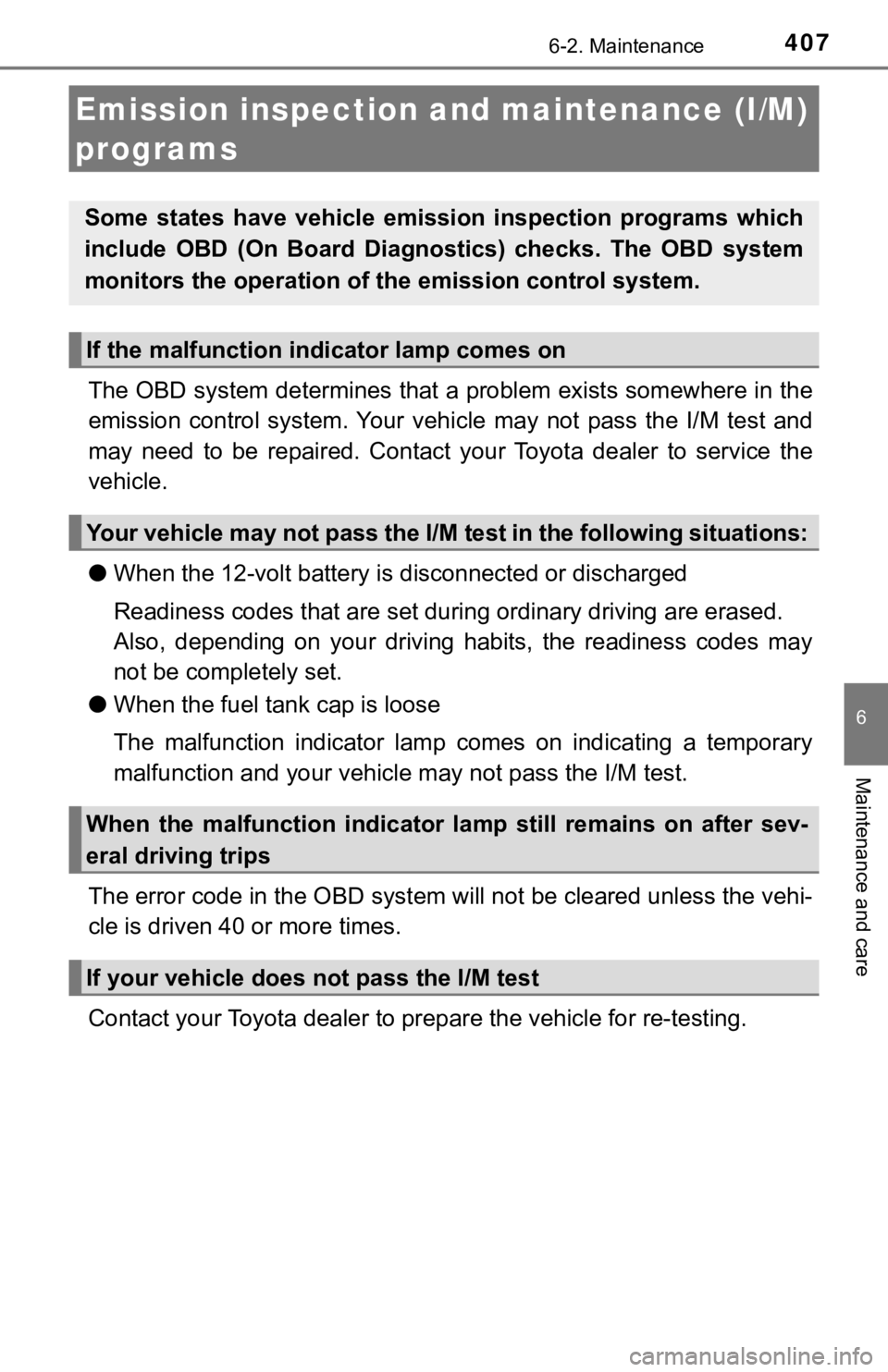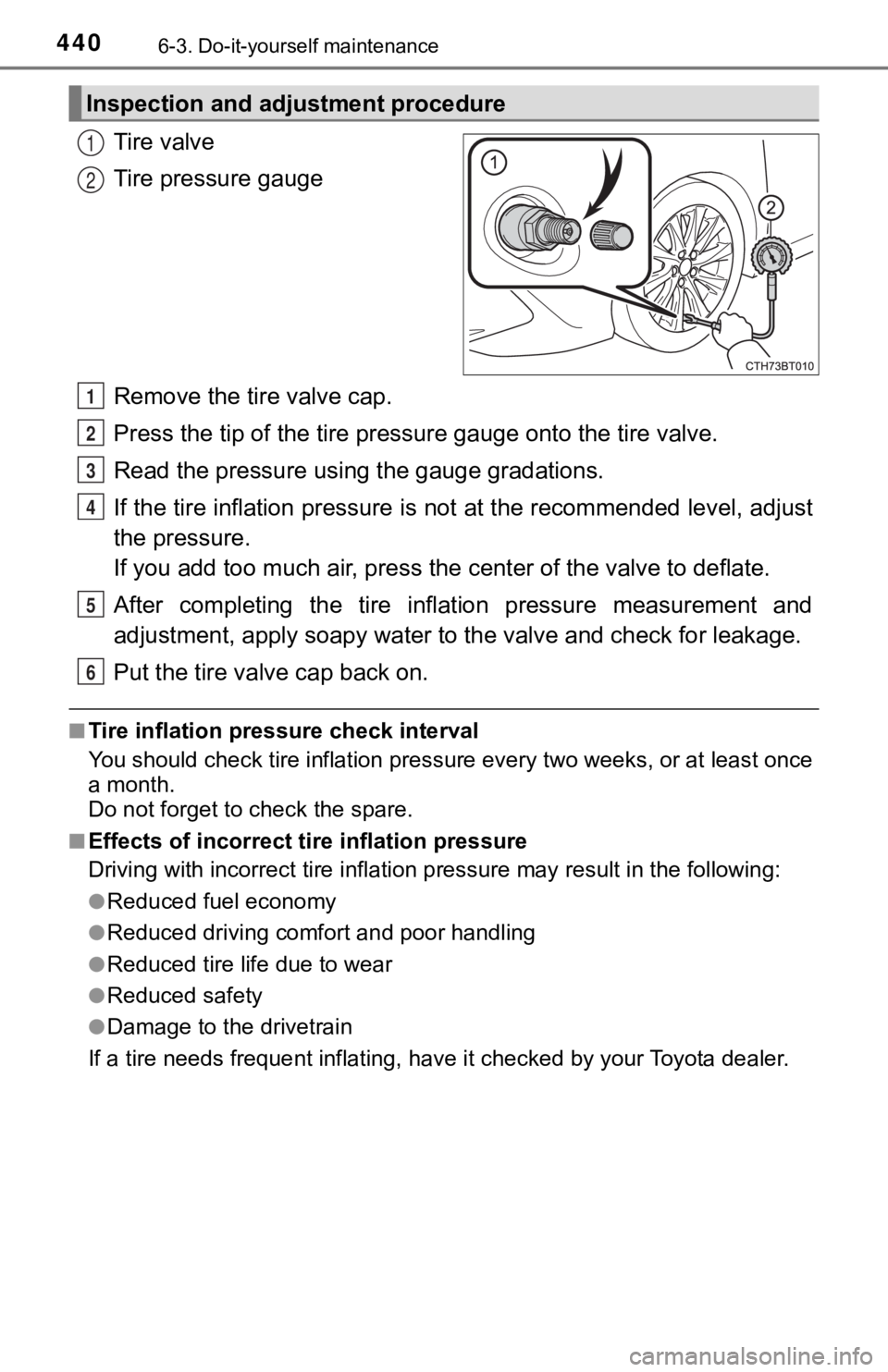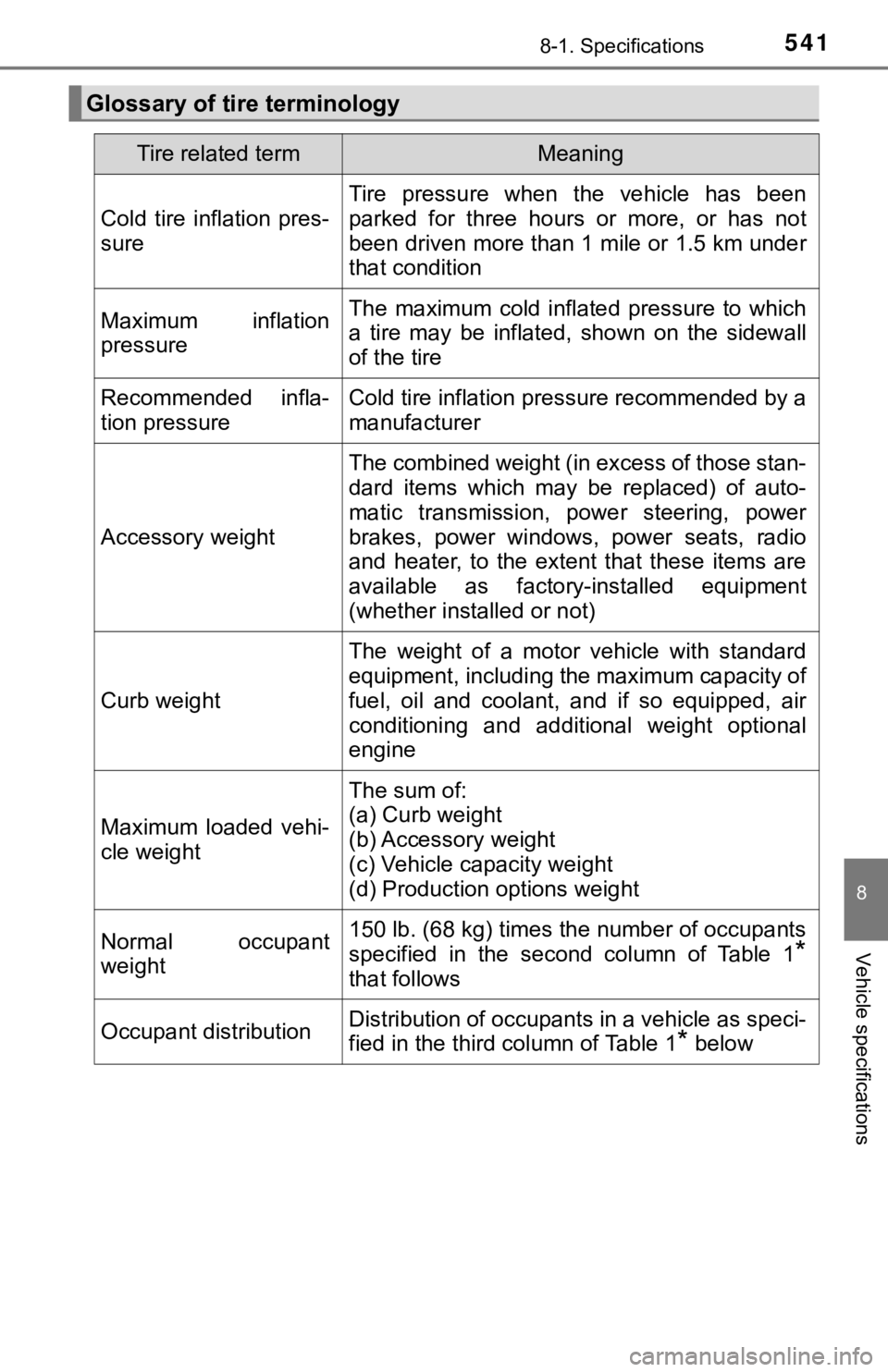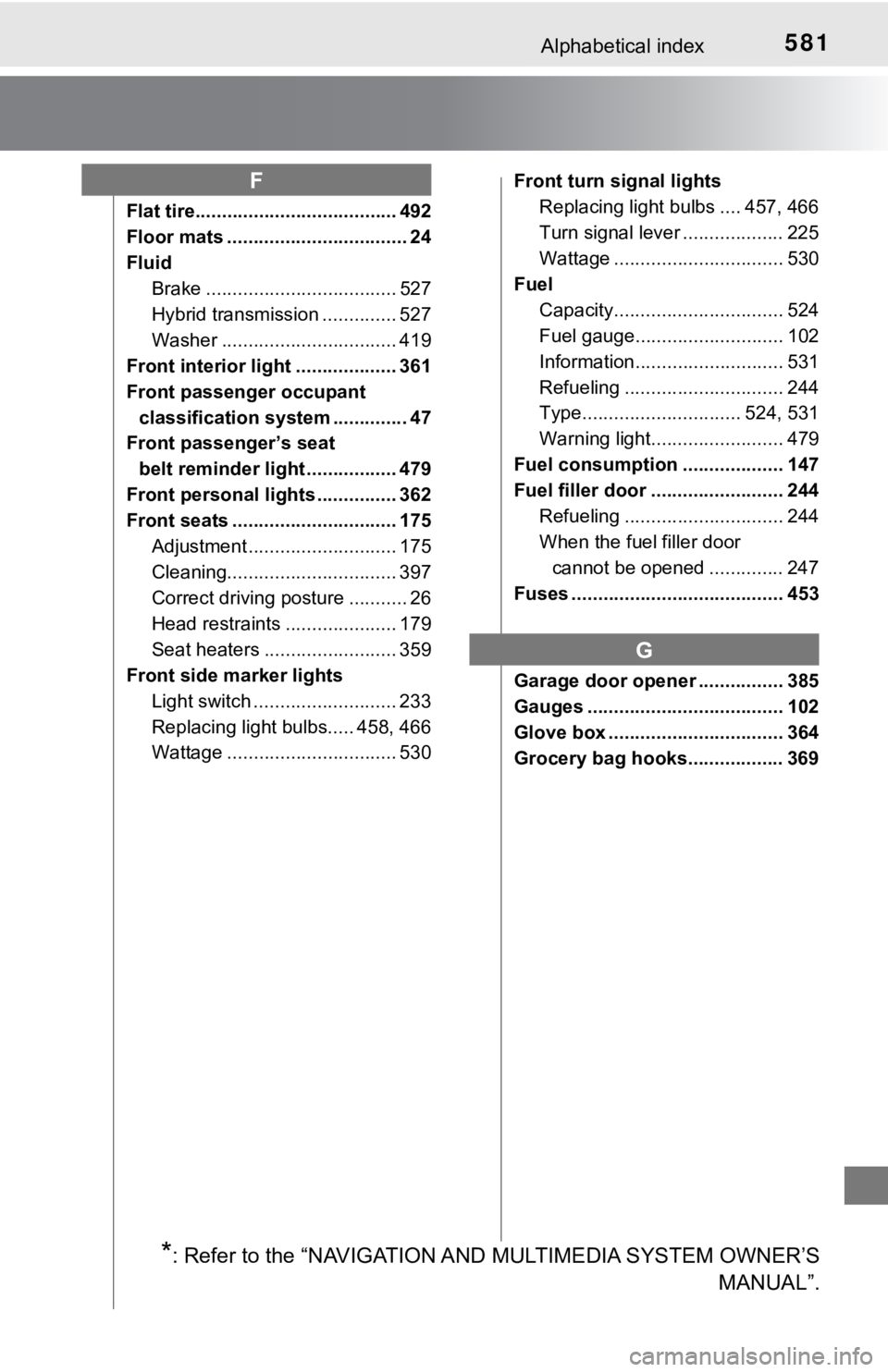Page 407 of 592

4076-2. Maintenance
6
Maintenance and care
The OBD system determines that a problem exists somewhere in the
emission control system. Your vehicle may not pass the I/M test and
may need to be repaired. Contact your Toyota dealer to service the
vehicle.
● When the 12-volt battery is disconnected or discharged
Readiness codes that are set duri ng ordinary driving are erased.
Also, depending on your driving habits, the readiness codes may
not be completely set.
● When the fuel tan k cap is loose
The malfunction indicator lamp comes on indicating a temporary
malfunction and your vehicle m ay not pass the I/M test.
The error code in th e OBD system will not be cleared unless the vehi-
cle is driven 40 or more times.
Contact your Toyota dea ler to prepare the vehicle for re-testin g.
Emission inspection and maintenance (I/M)
programs
Some states have vehicle emission inspection programs which
include OBD (On Board Diagnos tics) checks. The OBD system
monitors the operation of t he emission control system.
If the malfunction indicator lamp comes on
Your vehicle may not pass the I/M test in the following situations:
When the malfunction indicator l amp still remains on after sev-
eral driving trips
If your vehicle does not pass the I/M test
Page 440 of 592

4406-3. Do-it-yourself maintenance
Tire valve
Tire pressure gauge
Remove the tire valve cap.
Press the tip of the tire pressure gauge onto the tire valve.
Read the pressure using the gauge gradations.
If the tire inflation pressure is not at the recommended level, adjust
the pressure.
If you add too much air, press the center of the valve to defla te.
After completing the tire inflation pressure measurement and
adjustment, apply soapy water to the valve and check for leakage.
Put the tire valve cap back on.
■Tire inflation pressure check interval
You should check tire inflation p ressure every two weeks, or at least once
a month.
Do not forget to check the spare.
■Effects of incorrect tire inflation pressure
Driving with incorrec t tire inflation pressure may result in th e following:
●Reduced fuel economy
●Reduced driving comfort and poor handling
●Reduced tire life due to wear
●Reduced safety
●Damage to the drivetrain
If a tire needs frequent inflating , have it checked by your Toyota dealer.
Inspection and adjustment procedure
1
2
1
2
3
4
5
6
Page 481 of 592

4817-2. Steps to take in an emergency
7
When trouble arises
■SRS warning light
This warning light system monitors the airbag sensor assembly, front impact
sensors, side impact sensors (front door), side impact sensors (front), side
impact sensors (rear), driver’s seat position sensor, driver’s seat belt buckle
switch, front passenger occupant classification system (ECU and sensors),
“AIRBAG ON” indicator light, “A IRBAG OFF” indicator light, seat belt preten-
sioners, airbags, interconnecting wiring and power sources. ( P. 36)
■ Front passenger detection sensor, seat belt reminder and warnin g
buzzer
● If luggage is placed on the front passenger seat, the front pas senger detec-
tion sensor may cause the warning light to flash and the warnin g buzzer to
sound even if a passenger is not sitting in the seat.
● If a cushion is placed on the seat, the sensor may not detect a passenger,
and the warning light may not operate properly.
■ If the malfunction indicator lamp comes on while driving
First check the following:
●Is the fuel tank empty?
If it is, fill the fuel tank immediately.
● Is the fuel tank cap loose?
If it is, tighten it securely.
The light will go off after several driving trips.
If the light does not go off even after several trips, contact your Toyota dealer
as soon as possible.
Page 522 of 592
5228-1. Specifications
*1: Unladen vehicles
*2: For L, LE or XLE grade models
*3: For SE or XSE grade models
*4: 205/65R16 tires
*5: 215/55R17 tires
*6: 235/45R18 tires
Maintenance data (fuel, oil level, etc.)
Dimensions and weights
Overall length192.1 in. (4880 mm)*2
192.7 in. (4895 mm)*3
Overall width
72.4 in. (1840 mm)
Overall height*156.9 in. (1445 mm)
Wheelbase 111.2 in. (2825 mm)
Tread
Front63.0 in. (1600 mm)
*4
62.6 in. (1590 mm)*5
62.2 in. (1580 mm)*6
Rear
63.2 in. (1605 mm)
*4
62.8 in. (1595 mm)*5
62.6 in. (1590 mm)*6
Vehicle capacity weight
(occupants + luggage)
925 lb. (420 kg)
Page 524 of 592
5248-1. Specifications
*: Checking your vehicle’s model: P. 523
Engine
ModelA25A-FXS
Type4-cylinder in line, 4-cycle, gasoline
Bore and stroke 3.44 4.07 in. (87.5 103.4 mm)
Displacement 151.8 cu. in. (2487 cm3)
Valve clearance Automatic adjustment
Fuel
Fuel type Unleaded gasoline only
Octane rating87 (Research Octane Number 91) or higher
Fuel tank capacity
(Reference)13 gal. (49.3 L, 10.8 Imp. gal.)
Electric motor (Traction motor)
Type
Permanent magnet synchronous motor
Maximum output 88 kW
Maximum torque 149 ft•lbf (202 N•m, 20.6 kgf•m)
Hybrid battery (Traction battery)
AXVH70 model*AXVH71 models*
TypeLithium-ion battery Nickel-metal hydride bat-
tery
Voltage
3.7 V/cell 7.2 V/module
Capacity4.0 Ah 6.5 Ah (3HR)
Quantity70 cells 34 modules
Overall voltage 259 V 244.8 V
Page 525 of 592
![TOYOTA CAMRY HYBRID 2019 Owners Manual (in English) 5258-1. Specifications
8
Vehicle specifications
■Oil capacity (Drain and refill [Reference*])
*: The engine oil capacity is a reference quantity to be used when changing
the engine oil. Warm TOYOTA CAMRY HYBRID 2019 Owners Manual (in English) 5258-1. Specifications
8
Vehicle specifications
■Oil capacity (Drain and refill [Reference*])
*: The engine oil capacity is a reference quantity to be used when changing
the engine oil. Warm](/manual-img/14/42460/w960_42460-524.png)
5258-1. Specifications
8
Vehicle specifications
■Oil capacity (Drain and refill [Reference*])
*: The engine oil capacity is a reference quantity to be used when changing
the engine oil. Warm up the engine and turn off the hybrid syst em, wait
more than 5 minutes, and check the oil level on the dipstick.
■
Engine oil selection
“Toyota Genuine Motor Oil” is used in your Toyota vehicle. Use
Toyota approved “Toyota Genuine Motor Oil” or equivalent to sat -
isfy the following grade and viscosity.
Oil grade: API SN/RC multigrade engine oil
Recommended viscosity: SAE 0W-16
SAE 0W-16 is the best choice for
good fuel economy and good start-
ing in cold weather.
If SAE 0W-16 is not available, SAE
0W-20 oil may be used. However,
it must be replaced with SAE 0W-
16 at the next oil change.
Oil viscosity (0W-16 is explained here as an example):
• The 0W in 0W-16 indicates the characteristic of the oil which allows cold
startability. Oils with a lower value before the W allow for ea sier starting of
the engine in cold weather.
• The 16 in 0W-16 indicates the viscosity characteristic of the oil when the
oil is at high temperature. An oil with a higher viscosity (one with a higher
value) may be better suited if the vehicle is operated at high speeds, or
under extreme load conditions.
How to read oil container label:
API registered marks is added
to some oil containers to help
you select the oil you should
use.
Lubrication system
With filter 4.8 qt. (4.5 L, 4.0 Imp. qt.)
Without filter4.4 qt. (4.2 L, 3.7 Imp. qt.)
Outside temperature
Page 541 of 592

5418-1. Specifications
8
Vehicle specifications
Glossary of tire terminology
Tire related termMeaning
Cold tire inflation pres-
sure
Tire pressure when the vehicle has been
parked for three hours or more, or has not
been driven more than 1 mile or 1.5 km under
that condition
Maximum inflation
pressureThe maximum cold inflated pressure to which
a tire may be inflated, shown on the sidewall
of the tire
Recommended infla-
tion pressureCold tire inflation pressure recommended by a
manufacturer
Accessory weight
The combined weight (in excess of those stan-
dard items which may be replaced) of auto-
matic transmission, power steering, power
brakes, power windows, power seats, radio
and heater, to the extent that these items are
available as factory-installed equipment
(whether installed or not)
Curb weight
The weight of a motor vehicle with standard
equipment, including the maximum capacity of
fuel, oil and coolant, and if so equipped, air
conditioning and additional weight optional
engine
Maximum loaded vehi-
cle weight
The sum of:
(a) Curb weight
(b) Accessory weight
(c) Vehicle capacity weight
(d) Production options weight
Normal occupant
weight150 lb. (68 kg) times the number of occupants
specified in the second column of Table 1
*
that follows
Occupant distributionDistribution of occupants in a vehicle as speci-
fied in the third column of Table 1
* below
Page 581 of 592

581Alphabetical index
Flat tire...................................... 492
Floor mats .................................. 24
FluidBrake .................................... 527
Hybrid transmission .............. 527
Washer ................................. 419
Front interior light ................... 361
Front passenger occupant
classification system .............. 47
Front passenger’s seat
belt reminder light ................. 479
Front personal lights ............... 362
Front seats ............................... 175 Adjustment ............................ 175
Cleaning................................ 397
Correct driving posture ........... 26
Head restraints ..................... 179
Seat heaters ......................... 359
Front side marker lights
Light switch ........................... 233
Replacing light bulbs..... 458, 466
Wattage ................................ 530 Front turn signal lights
Replacing light bulbs .... 457, 466
Turn signal lever ................... 225
Wattage ................................ 530
Fuel Capacity................................ 524
Fuel gauge............................ 102
Information............................ 531
Refueling .............................. 244
Type.............................. 524, 531
Warning light......................... 479
Fuel consumption ................... 147
Fuel filler door ......................... 244 Refueling .............................. 244
When the fuel filler door cannot be opened .............. 247
Fuses ........................................ 453
Garage door opener ................ 385
Gauges ..................................... 102
Glove box ................................. 364
Grocery bag hooks.................. 369
F
G
*: Refer to the “NAVIGATION AND MULTIMEDIA SYSTEM OWNER’S MANUAL”.